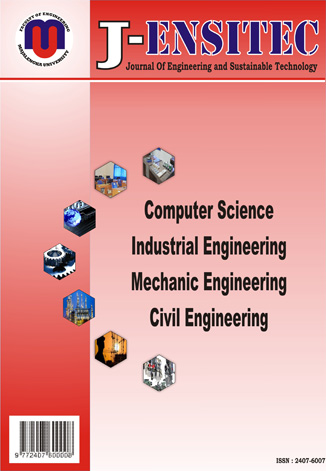PERANCANGAN ALAT PENGATUR KELEMBAPAN OTOMATIS PADA MESIN HATCHER TELUR BEBEK DENGAN METODE QUALITY FUNCTION DEPLOYMENT (QFD)
DOI:
https://doi.org/10.31949/jensitec.v10i02.9264Abstrak
The duck farming business is an activity where farmers process ducks to breed and maintain them to obtain benefits and results from this activity. Ducks are quite popular among various groups, from small children to the elderly. UMKM in the Jombang area are located on Jl. Gatot Subroto No. 29A Mojongapit, Jombang. These UMKM are KUB chicken farms and broiler duck hatcheries. Hatching of broiler ducks is carried out using an automatic hatching machine that can turn the eggs automatically. The UMKM hatching machine processes 500 eggs each period. If the temperature and humidity method is not checked periodically, the egg hatching yield will be 75%. If you want to increase the hatching presentation, you can check regularly to reach 80%, but this takes too much time and energy. Therefore, I will make a tool that can regulate the humidity of the incubator. In solving this problem, the QFD method is used to fulfill consumer desires in making tools. Using the QFD method will make the tool making more optimal because before the tool is made a survey is carried out to determine consumer interest. The results of this research are tool designs that are made according to consumer interests.
Kata Kunci:
hatcher, egg, QFD, duck, temperatureUnduhan
Referensi
M. E. Abd El-Hack, C. B. Hurtado, D. M. Toro, M. Alagawany, E. M. Abdelfattah, and S. S. Elnesr, “Impact of environmental and incubation factors on hatchability of duck eggs,” Biol Rhythm Res, vol. 53, no. 1, pp. 79–88, 2022, doi: 10.1080/09291016.2019.1628394.
S. Indarwati, S. M. B. Respati, and D. Darmanto, “Kebutuhan Daya Pada Air Conditioner Saat Terjadi Perbedaan Suhu Dan Kelembaban,” Jurnal Ilmiah Momentum, vol. 15, no. 1, pp. 91–95, 2019, doi: 10.36499/jim.v15i1.2666.
A. Muhajirin, “Daya Tetas, Hasil Tetas Dan Lama Menetas Telur Itik Yang Disimpan Pada Suhu Dan Lama Penyimpanan Yang Berbeda,” 2015, [Online]. Available: http://repository.uin-suska.ac.id/6149/
J. F. Sibarani, “Perancangan Inkubator Penetas Telur Itik Berbasis PID,” pp. 1–74, 2021, [Online]. Available: http://scholar.unand.ac.id/76786/%0Ahttp://scholar.unand.ac.id/76786/5/TUGAS AKHIR FULL SKRIPSI.pdf
Y. S. Magita and S. M. Khoiroh, “Analisa Kepuasan Konsumen Sebagai Upaya Peningkatan Kualitas Produk GPS Tracker Menggunakan Metode Quality Functiondeployment (QFD) di PT MCE Surabaya,” Prosiding Senakama, pp. 1–11, 2023.
Y. Maulana, W. A. Fahrudin, B. Aprina, Taufik, and Wahyu, PERENCANAAN & PERANCANGAN PRODUK. Pamulang: Unpam Press, 2022.
R. Jakaria and T. Sukmono, PERENCANAAN DAN PERANCANGAN PRODUK. Sidoarjo: Umsida Pers, 2021.
A. D. Saputro, H. F. Satoto, A. T. Industry, and D. T. Industri, “Rancang bangun mesin perajang tembakau dengan memperhatikan aspek ergonomi,” no. Djumali 2016, 2018.
I. C. Laksmana and H. F. Satoto, “Usulan Perbaikan Fasilitas Kerja pada Produksi Parutan Kelapa Berdasarkan Hasil Evaluasi QEC dan REBA,” JIEMS (Journal of Industrial Engineering and Management Systems), vol. 16, no. 1, pp. 137–162, 2023, doi: 10.30813/jiems.v16i1.4564.
H. F. Satoto and M. Khotib, “PERANCANGAN ALAT PEMBENTUK PASAK PERAHU DENGAN PENDEKATAN ERGONOMI GUNA MENINGKATKAN PRODUKTIVITAS DAN MENURUNKAN KELELAHAN KERJA,” pp. 165–172, 1945.
Diterbitkan
Cara Mengutip
Terbitan
Bagian
Lisensi
Hak Cipta (c) 2024 Ilham Dwi Septian, Handy Febri Satoto

Artikel ini berlisensiCreative Commons Attribution-ShareAlike 4.0 International License.
An author who publishes in the J-ENSITEC (Journal of Engineering and Sustainable Technology) agrees to the following terms:
- Author retains the copyright and grants the journal the right of first publication of the work simultaneously licensed under the Creative Commons Attribution-ShareAlike 4.0 License that allows others to share the work with an acknowledgment of the work's authorship and initial publication in this journal
- The author is able to enter into separate, additional contractual arrangements for the non-exclusive distribution of the journal's published version of the work (e.g., post it to an institutional repository or publish it in a book) with the acknowledgment of its initial publication in this journal.
- The author is permitted and encouraged to post his/her work online (e.g., in institutional repositories or on their website) prior to and during the submission process, as it can lead to productive exchanges, as well as earlier and greater citation of the published work







